Horsebox Payloads

Table of Contents
Written by Kevin Parker of KPH
Introduction to Horsebox Payloads
Payload is without doubt one of the top priorities in any horsebox search and I cannot emphasize how crucial this point is.
Buying something where the payload falls short of your requirements, means you run the risk of going over the allowed Maximum Authorised Mass (MAM) and this will expose you to prosecution, it makes your insurance void and puts yourself, your horses, and other road users at risk!
Horsebox payloads can be a daunting subject for horsey customers, especially if they are new to horsebox ownership. It is a subject that, unless they are involved in goods transport, heavy bombers or explosive warheads, is unlikely to have crossed their paths before.
Unlike buying a car, where weight is never mentioned, payload is an integral aspect of horsebox ownership. For many customers, staying safe and legal, means learning a whole new subject.
For customers who need clarification, I have written this article to help break down the acronyms and jargon and explain horsebox payloads in a straightforward way.
I will start at the very beginning, with a simplified definition of payload, but only where it relates to a horsebox and not as mentioned above, explosive warheads!
So, as an example, you are looking to buy a 4.5 tonne horsebox, payload is basically the amount of load you can legally add to the empty horsebox without exceeding the 4.5 tonne maximum authorised mass.
Horsebox Payloads includes, amongst other things, water, fuel, people, horses and tack.
Technical terms and acronyms
If you are new to horseboxes and considering buying your first one, you may never have heard some of the terms or acronyms used.
They are certainly complicated and often there are more than a few with the same meaning thrown in to confuse the issue further.
Unladen Weight
This is the weight of the horsebox when it is not carrying any passengers, goods or other items. It includes the body and all parts normally used with the vehicle when it’s used on a road. It does not include the weight of fuel or water.
MAM
Maximum Authorised Mass (MAM) is the weight of the horsebox including the maximum load that can be carried safely when it’s being used on the road.
This is also known as Gross Vehicle Weight (GVW) or Permissible Maximum Weight (PMW). It will be listed in the owner’s manual and is normally shown on a plate or sticker fitted to the vehicle.
Horsebox Payload
This is calculated by removing the unladen weight from MAM.
Weight certificate caution
I have been pushing the importance of horsebox payloads for over 20 years, as it was initially a way for us to give customers confidence and keep them safe and legal.
Happily, with a more informed public leading the charge, weight certificates have become almost commonplace.
However, I would add some words of caution here:
1. Look out for the term ‘weight certificate provided’ in sales adverts.
At face value it sounds above board, but the crucial information you need is the payload amount in KG. This will allow you to calculate if your horses and associated tack will fit within the MAM.
2. When weighing, it is common practice for some sellers to remove heavy items like rubber mats or horse partitions to ‘cheat’ on the stated payload. When caught out or questioned they often claim ignorance.
My best advice here is take nothing at face value, if you have the slightest doubt whatsoever, weigh the horsebox yourself.
What payload will you need in your new horsebox?
Start with a simple horsebox weight calculation.
When considering the payload you will need in a new horsebox, you must have some context to make an informed decision. So, this is a sensible exercise to show the exact payload you will require and it is the easiest route to staying safe and legal on the road. It works for any size of horsebox and it means you will be armed with indisputable facts.
Starting with an empty horsebox (unladen) with little fuel, no water, no tack and no horses – weigh the horsebox at your local weighbridge making sure you and any passengers are not in the horsebox or on the weighbridge. This will give you the unladen weight.
Next fill the horsebox (laden) with fuel, water, all tack and all the horses you intend to carry and weigh again at your local weighbridge making sure you and any passengers remain in the horsebox.
Now you will have figures in kilograms for laden and unladen weight. To do the math, take the unladen weight from the laden weight and this will give you the amount of payload your new horsebox must have as a minimum. You will probably be shocked at the payload you need!
It is not always possible to get to the bottom of what you actually need when a weighbridge is not an option. So the next best option that I would advise is to get an approximate handle on what your horses and tack weigh.
Approximate weight guide
As an exercise, I asked the ‘horsey community’ the weights of their horses and tack etc. and below I have put together a brief list of approximate item weights for customers to calculate their requirement for their horsebox payload.
 1. Horses
1. Horses
When discussing payloads I had always used 600 kg as an average horse weight. In surveying my customers, I established that horse weights typically range from 430 to 710 kg.
I calculated the average to be 542 kg, however, for my examples when talking to unsure customers I will stick to using 600 kg as an average horse.
2. Fuel
Fairly easy to calculate this, as approximately 1 litre of fuel weighs 1 kg.
As an example an Aeos 4.5 tonne horsebox has a 90 litre fuel tank (giving a range of approximately 692 miles), so a full tank weighs 90 kg.
3. Water
Again, easy to calculate this as approximately 1 litre of water weighs 1 kg.
As an example, a Aeos Weekender horsebox has 85 litre water tank, so full to the brim 85 kg of water.
This is really an unnecessary amount to carry for every single trip, when all that is really needed for most journeys is enough to water the horses during the trip. It will save weight and fuel costs if you fill up at your destination.
4. Saddles
For saddles we usually allow 10 kg each and most customers had saddles at this weight or less.
One customer had a saddle 20 kg plus but for the sake of finding middle ground we will stick with an average of 10 kg each.

5. People
Again, this can be a can of worms with weights ranging from children to adults. Choosing middle ground again we will plump for 80 kg each.
6. Hay bale
Most said 20 to 23 kg each bale, so we will err on the side of caution and say 25 kg
7. Shavings bale
Most customers said 10 kg each bale
8. Assorted equipment
This can really be a long list with everything from food and first aid kits to brushes and assorted tack. It would be very difficult to generalise here as most disciplines differ dramatically in the amount and weight of auxiliary equipment. I think it fair to say this needs careful consideration and some weight allowance made.
Lightweight horseboxes
Many of the issues with overweight horseboxes stem from cost, where cheap manufacturing usually equates to heavy horseboxes with little payload.
I know all too well that lightweight horseboxes with good payload cost considerably more to manufacture. By designing horseboxes from the ground up, around cutting edge materials and processes, it is possible to manufacture lightweight horseboxes.
Although a more expensive route, these materials and processes have many benefits for our own horseboxes. These include added strength, stiffer construction, reduced vibration, reduced noise, improved appearance, added longevity and much reduced corrosion, to name but a few.
If you are just starting a search, it is a minefield and my best advice is research thoroughly, ask questions on the forums and social media and check the weight certificate.
Axle loading & vehicle overhang
As an example of axle loading, say your 7.5 tonne horsebox is fully loaded with fuel, water, horses, tack, people and weighs a very legal 7.4 tonnes. So it’s within the law, but this may not necessarily be the case and you still may face prosecution if you have placed your load (horses) incorrectly.
Following on from payload, here is a brief explanation of axle loading and vehicle overhang; it is much simplified to keep it short, but it’s worth reading as it has a large impact on staying legal.
Axle loading
This is the weight limit each axle can legally and safely take, the manufacturer records this on a stamped plate in the cab.
3.5 and 4.5 tonne horseboxes
For Aeos horseboxes we use either the Citroën Relay, Peugeot Boxer or Fiat Ducato chassis, as all three are the same van platform. The diagram shows the front and rear axle loading.
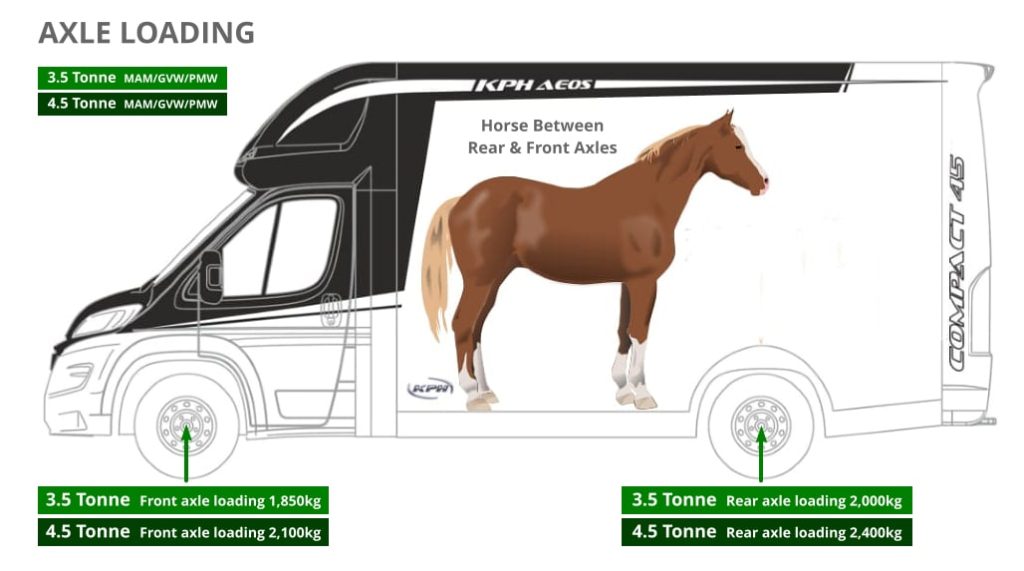
7.5 tonne horseboxes
We specialise in the DAF LF range and they typically state 3.6 tonnes for the front axle and 5 tonnes for the rear. The diagram shows a DAF LF chassis side view as a reference.
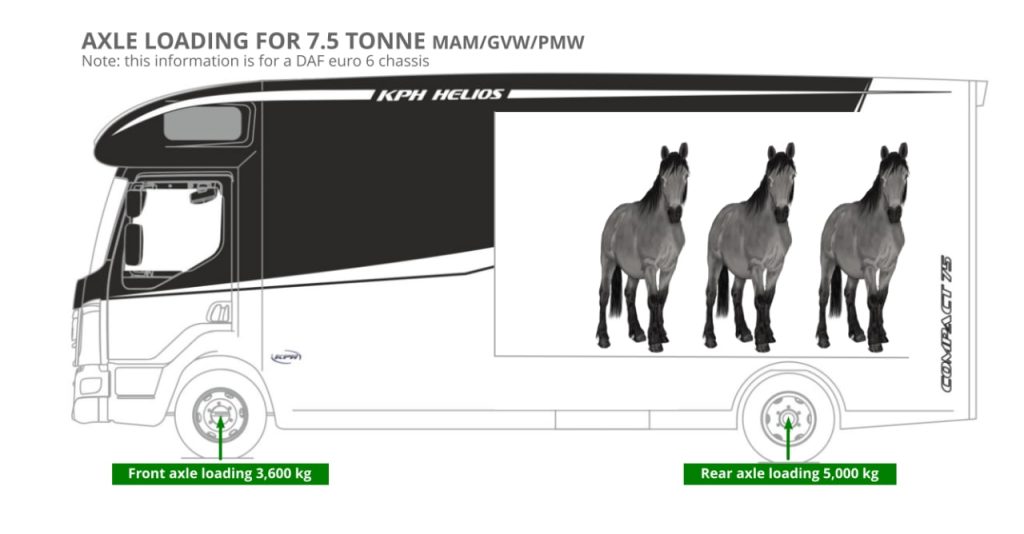
Loaded, your horses should be evenly spaced over the rear axle. If you carry three horses, the middle one should stand over the centre of the rear axle. If it’s two horses there should one stood on each side of the rear axle and if only one horse, it should be stood directly over the rear axle centre.
Fuel, water and other tack does come into play; however a responsible manufacturer should have taken this into consideration when designing the horsebox and where your horses will stand.
What actually happens if you place your horses in front of the rear axle is that it places more weight on the front axle, so the front axle may be overloaded. Placing the same horses behind the rear axle will put all the weight on the rear axle overloading that.
Really it’s a balancing act that your manufacturer should have designed around, leaving you little room for loading errors.
Vehicle overhang
Overhang is the distance from the centre of rear wheel to the very back of the wagon.
At the design stage a competent manufacturer should take the number of horses to be carried and evenly space them over the rear axle, in order to determine where the overhand ends.
7.5 tonne horseboxes:
For our KPH 7.5 tonne Helios horsebox range they are fixed at 1550 mm (61”) overhang, placing the horses directly over the rear axle.
3.5 and 4.5 tonne horseboxes:
Overhang is less of an issue with our Aeos 3.5 tonne , Aeos 4.5 tonne and Aeos 7.2 tonne range. We place the horses between the front and rear axle to balance the axle loadings. This leaves the lighter living or grooms area in the overhang portion of the horsebox.
By design we work out the overhang for each model and place the main weight to be carried in the best possible position to reduce the chances of loading errors.
Real life example
I have a very good friend who transports horses to and from the Isle of Man. Her horsebox was weighed with three horses and was perfectly legal. It had a very large horse loaded first, then two smaller ponies.
After dropping off the two small ponies, the large horse was left in the front stall. When weighed this time the front axle was overweight.
She was lucky enough to get a warning and made to reload the large horse into a middle stall.
I often use this as an explanation of horsebox payloads and positioning for customers and it highlights perfectly how easy it is to fall foul of the law!
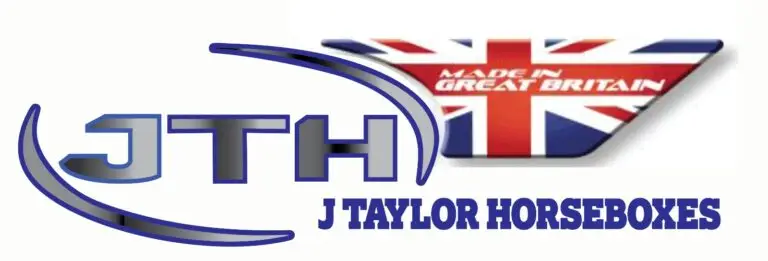
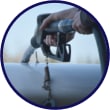


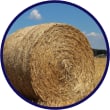
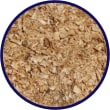

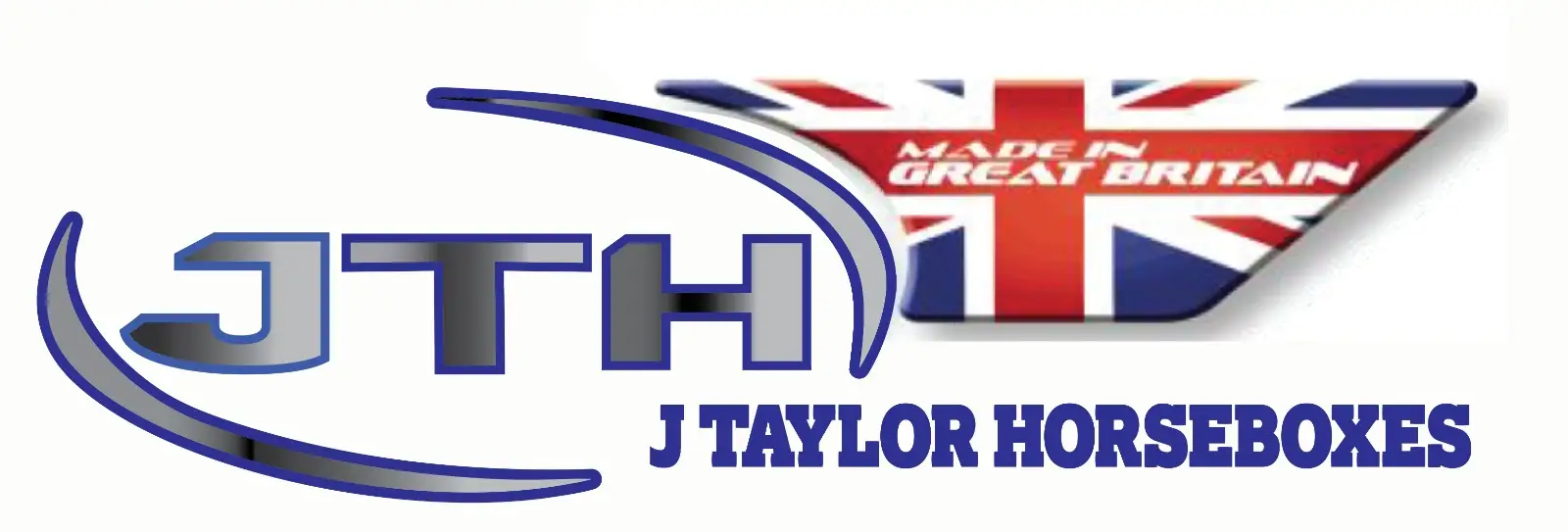

3 responses